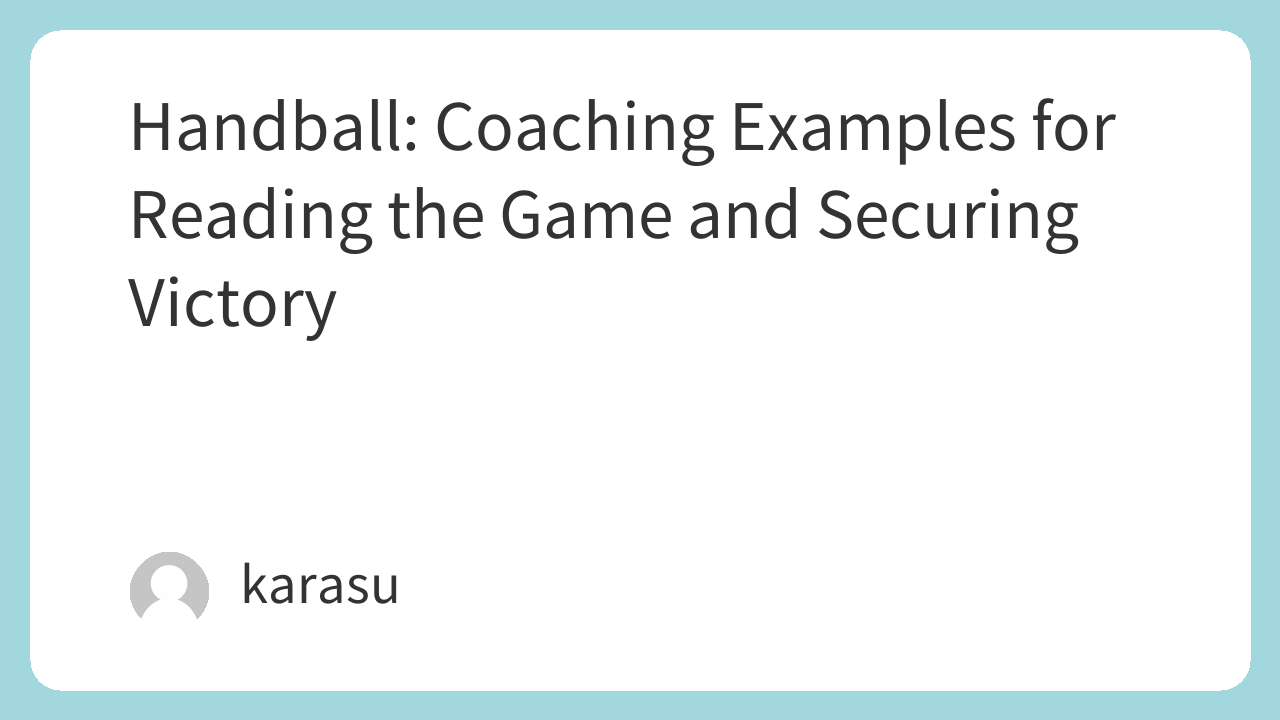In handball, the game situation changes by the minute. The decisions made by the manager or coach are crucial for interpreting these changes and guiding the team to victory. Here, we’ll look at specific game scenarios and explain effective coaching examples.
1. When Your Team is Leading
A lead of a few goals provides a mental cushion, but complacency is dangerous. Adjust the balance between offense and defense based on the score difference and remaining time.
- Stable Lead (4+ goals)
- Stabilize Defense: Avoid risky defensive plays. Instruct your team to minimize fouls while consistently reducing the opponent’s scoring opportunities. A zone defense (e.g., 6-0) focused on solidifying the center is often more effective than an expansive, highly mobile defense.
- Slow Down Offense: While still looking for fast breaks, instruct players not to rush their attacks. Instead, encourage patient ball movement to create clear shooting opportunities. This strategy also uses time to induce urgency and mistakes from the opponent.
- Rest Key Players: Substitute in reserves to reduce the fatigue of key players, ensuring they are fresh for critical moments in the late stages of the game. It’s especially important to sub out players with accumulated fouls to avoid the risk of suspensions.
- Unstable Lead (1-3 goals)
- Maintain Focus: Remind players that the lead is still narrow to prevent complacency. Emphasize fundamental plays, as minor mistakes can lead to conceded goals.
- Emphasize Transition Speed: Teams often concede fast breaks or easy goals when leading. Instruct players for quick returns to defense and appropriate matchups to prevent opponent fast breaks.
- Defensive Maneuvering: Against the opponent’s ace, instruct players to force them into specific shooting angles, even if it means committing a foul. Sometimes, a double team can be used to apply pressure. However, be mindful of foul trouble.
2. When Your Team is Trailing
To close the gap and come back, a balance of boldness and composure is crucial.
- Small Deficit (1-3 goals)
- Increase Offensive Tempo: Instruct players to quicken their passing and aggressively seek out shots. It’s also effective to increase high-percentage scoring patterns like pivot plays and wing shots.
- Emphasize Fast Breaks: After opponent mistakes or conceded goals, strongly encourage quick transitions to offense to score easy points. Accurate long passes from the goalkeeper are also vital.
- Aggressive Defense: Instruct players to focus on winning the ball back quickly to reduce the opponent’s attacking time. Consider a 5-1 defense to pressure the center back, or man-to-man defense against the opponent’s ace.
- Utilize Time-outs: This is an excellent opportunity to break the opponent’s momentum, instruct specific offensive patterns, or make defensive adjustments. It’s particularly effective immediately after conceding consecutive goals when the team might be flustered.
- Large Deficit (4+ goals)
- Bold Tactical Changes: As traditional attacks might not be enough to catch up, consider a “power play” where the goalkeeper is substituted for an additional field player, creating a numerical advantage to score. However, this carries the risk of conceding an empty-net goal.
- Strict Shot Selection: Avoid reckless long-range shots or shots from difficult angles. Instead, instruct players to focus on converting higher-percentage scoring opportunities.
- High-Risk, High-Reward Defense: Instruct players to aggressively pursue ball recovery with tactics like an all-court press or anticipating pass lanes for interceptions. However, this also increases the risk of being beaten.
- Player Communication: Even in seemingly hopeless situations, encourage players with positive words to prevent them from giving up and to urge them to fight until the very end.
3. When the Game is Tied (or 1-goal difference)
Especially in the late stages, a single play can decide the outcome. A balance of composure and audacity is required.
- Emphasize Calm Judgment: Instruct players to remain calm and execute each play carefully. Avoid unnecessary fouls to reduce the risk of suspensions.
- Reliable Offensive Setups: Missing a shot gives the opponent possession. Instruct specific set plays and coordinated plays that lead to more reliable scores, minimizing mistakes. Encourage high-percentage shots like wing shots or pivot plays.
- Foul Control in Defense: Instruct players to avoid easy fouls in defense to prevent giving the opponent 7-meter throws (penalty shots). However, tactical fouls to prevent crucial opponent shots can be an option, but this also carries the risk of a suspension.
- Time-out Timing: In a close game with little time remaining, use the time-out at the most effective moment to give instructions for the final attack or defense. Calling a time-out immediately after the opponent’s time-out can also provide time to react to their strategy.
- Instructions for the Final Play: If only a few seconds remain in the game, provide specific instructions on how to get a shot off on the final possession, or how to defend against the opponent’s shot. For example, instruct to get the ball to a specific player for a shot, or for everyone, including the goalkeeper, to return to defense.
Successful Coaching: It Comes Down to Preparation and Trust These coaching examples are just a few possibilities. Ultimately, the success of coaching depends heavily on the manager’s and coach’s prior preparation (scouting and tactical review in practice), in-game observation skills, and the trust built with the players.



コメント